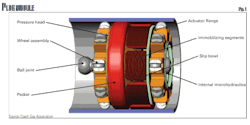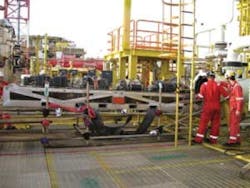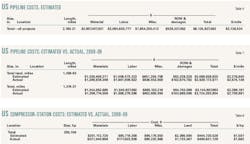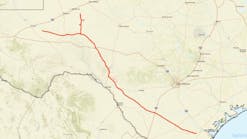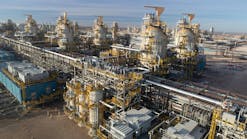Pressure isolation and hot tapping, traditionally used for repair, play an increasingly important role in the maintenance and expansion of both offshore and onshore natural gas pipeline systems. An agreement between TDW Offshore Services AS and Amserve Engineering to service Sarawak Shell Berhad's Malaysian pipeline assets serves as one example of this development.
Background
Pipeline pressure isolation typically occurs in conjunction with valve change-outs on export lines in the event of leakage. Offshore isolations of valves with a 24-38 in. bore typically require a four-man crew to launch, monitor, and retrieve a tool such as TDW's SmartPlug. Operations take 2-4 weeks depending on circumstances.
The isolation system avoids:
• Gas flaring, displacement of pipeline contents.
• Production during shutdown repairs.
• Gas, hydrocarbon vapor emissions.
• Holes, future leak paths.
• Decommissioning, recommissioning.
• Hydrate, chemical, contaminated water disposal.
The tool can isolate any pipeline medium, including natural gas, crude oil, distillates, treated or untreated waters, glycol, etc., in pipe of 10-42 in. OD. Each of its two independent plug modules, activated by an onboard micro-hydraulic system, can isolate the full pipeline pressure, providing double-block isolation. It self-locks in position as long as there's a pressure delta across the tool and can be unset and recovered even if communication fails. Differential pressure produces a thrust load on the tool which it transfers to the pipe wall. The tool communicates with the surface via an ELF antenna allowing two-way contact between it and the operator.
Tool actuation
Threaded hardened steel segments immobilize the tool in the pipeline. Pressurizing the set side of the internal hydraulic cylinder moves the piston from right to left, activating the segments and causing them to slide up the bowl and expand radially.
Machined threads on the outer surfaces of the segments allow their teeth to penetrate the surface of the pipeline's inner wall by a few thousandths of a millimeter, well within API tolerances. Engaging one third of the segments provides sufficient grip for isolation.1
Setting the SmartPlug at the end of a dry pipeline before laying allows dry tie-ins with less expensive vessels and prevents flooding during handover between vessel and platform should a wet buckle occur. Placing one tool on either side of a preinstalled tee allows tie-in of pipelines without shutting down the pipeline, flooding, or environmental remediation.
Malaysian work
The project for Shell, focused on maintaining and expanding its assets in the region as opposed to addressing an emergency leak, will require double blocks in a number of sections to fully isolate the work area from hydrocarbons. Attempting to perform the work without such blocks would require bleeding of the line, which can be both costly and time consuming.
Work covers Shell's facilities in the South China Sea, off western Borneo, including the M3, B11, E11 RB, F23 and F6 platforms, 80-200 km from Miri and Bintulu, Sarawak. Natural gas currently travels through four trunklines to an onshore processing plant in Bintulu. Shell operates the development for a joint venture between it and Petronas Carigali Sdn. Bhd.
Successful isolations of platforms F23 and M3 have already occurred, with plans in place to tie-in a new line to F23 and replace two valves on E11 RB during the balance of 2009. Plugs used have been assembled, tested, and mobilized from TDW-Stavanger via Labuan, Malaysia.
The E11 Hub integrated gas project, Shell EP Asia Pacific's largest ongoing project, will centralize production from surrounding fields through one integrated hub, shipping processed gas to Petronas's Malaysia LNG Bintulu complex.2
The MLNG Bintulu complex, operating since 1983, consists of the Satu, Dua, and Tiga projects, with its combined capacity of 1.1 tcf/year ranking as the largest in the world. An expansion of Dua is scheduled for completion in 2010.3 As of August 2006 MLNG Japan bought 65% of Bintulu's production, with the balance shipped to Korea (26%) and Taiwan (9%).
Onshore applications
Pressure isolation tools are also becoming more common in onshore applications. The difficultly and expense of otherwise interrupting flow in offshore lines, combined with the greater strength of the lines themselves, saw pressure isolation tools first used in this arena.
As the prices of transported products have risen, however, and environmental concerns and regulations have mounted, in-service pressure isolation has become an increasingly viable alternative for onshore modifications and maintenance as well. The use of external reinforcing clamps has addressed concerns regarding insufficient WT or pipe grade in older high-pressure onshore systems.
A 2007 World Bank document addressing HSE issues related to onshore oil and gas development explicitly calls for safe isolation procedures before beginning work on existing infrastructure.4
Initial onshore use of the tool for a pig trap isolation on Vebundnetz Gas Aktiengesellschaft (VNG) roughly 7,000 km natural gas transmission grid in eastern Germany prevented the loss of about 110,000 cu m of natural gas, any fines or remediation, and re-commissioning of the pipeline itself. A second onshore application isolated 120 m of a 62 km portion of ONTRAS—VNG Gastransport GMBH's to replace the 120-m section without interrupting service.
In both instances 38-in. diameter pressure-isolation pigs were deployed to an excavated section of pipeline roughly 100 m from a pig launcher. Pipeline pressure was held at 50 bar for 3 days during isolation, with each operation taking 10 days from arrival to completion.1
References
1. Sim, M., Abdulla, M., and Weissenbock, G., "Non-invasive Remote Pressure Isolation Reduces Flaring and Product Loss," Czech Gas Association, 18th Colloquium, Safety and Reliability of Pipelines, Prague, May 12-13, 2009.
2. http://www.shell.com.
3. http://www.eia.doe.gov/emeu/cabs/Malaysia/NaturalGas.html, September 2009.
4. World Bank Group, International Finance Corp., "Environmental, Health, and Safety Guidelines: Onshore Oil and Gas Development," Apr. 30, 2007.
Correction
In the article "Pipeline profits, capacity expansion plans grow despite increased costs" by Christopher E. Smith, Tables 4, 7, and 8 (OGJ, Sept. 14, 2009, pp. 66, 69, and 70) contained errors. Following are corrected versions of the affected portions of each table. The corresponding data have also been updated in the OGJ Research Center Database.
